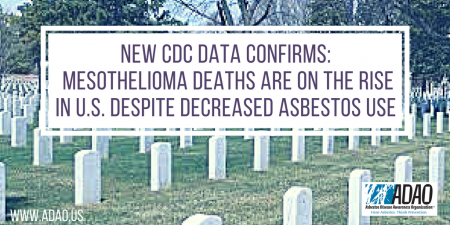The Center for Disease Control and Prevention (CDC) released new data this week reporting an increase in annual mesothelioma deaths in the United States.
According to the report, “During 1999–2015, the annual number of malignant mesothelioma deaths increased 4.8% overall, from 2,479 in 1999 to 2,579 in 2015.”
This confirms what we in the asbestos victim community have known for years: As much as people want to believe asbestos is a problem of the past, we know all too well that it remains a threat to this day. This new CDC data is proof.
“Despite regulatory actions and the decline in use of asbestos the annual number of malignant mesothelioma deaths remains substantial,” the report reads. It’s important to remember, too, that this study only analyzed mesothelioma deaths, which account for just a fraction of fatal asbestos-caused illnesses — asbestos caused lung cancer occurs at a rate at least 4x that of mesothelioma. Using the report’s figure of 45,221 mesothelioma deaths between 1999-2015, we can confidently add to that at least 180,884 deaths due to asbestos-caused lung cancer in the same time period.
Younger Patients Indicate Continued Exposure
While the biggest increase in number of deaths was among people 85 and older — which is in line with the 10-50 year latency period associated with asbestos disease — the comprehensive report also lists 682 mesothelioma deaths among people 25-44 years old. The report did not analyze asbestos-related deaths for individuals younger than 25.
The study analyzed in the report focused largely on occupational exposures, naming several high risk occupations including insulation workers, construction workers, and chemical technicians. The report also discussed environmental and secondary exposures, which we know contribute to a new, younger patient profile for mesothelioma.
“Family members of workers engaged in activities placing them at risk for asbestos exposures also have the potential for exposure to asbestos,” the report explains.
Policy Hasn’t Provided Sufficient Protection
The numbers of young people being sickened by asbestos is evidence that the uptick in mesothelioma deaths is not solely the result of legacy asbestos consumption. Rather, it “suggests ongoing occupational and environmental exposures to asbestos fibers, despite regulatory actions by the Occupational Safety and Health Administration (OSHA) and the Environmental Protection Agency (EPA) aimed at limiting asbestos exposure.”
OSHA has long espoused limits on how much asbestos can legally be present in a workplace, though the agency maintains that there is no safe level of exposure to asbestos. Unfortunately, though, the CDC report says that “20% of air samples collected in the construction industry in 2003 for compliance purposes exceeded the OSHA permissible exposure limit.”
The EPA, after concluding that the asbestos posed an undue threat to human health, attempted to ban asbestos in 1989, only to have the ban overturned in appeals 1991 thanks to weak chemical safety laws that hamstrung the EPA’s regulatory capacity. The EPA has since only managed to regulate five asbestos applications, and as such “asbestos products remain in use, and new asbestos-containing products continue to be manufactured in or imported into the United States.”
As the report states, we as a country must do much more to regulate asbestos and mitigate the risk of exposure: “The continuing occurrence of malignant mesothelioma deaths underscores the need for maintaining measures to prevent exposure to asbestos fibers…and for ongoing surveillance to monitor temporal trends.”
Prevention is the Only Cure — Policy Must Reflect That
Unfortunately, as we know, while promising research continues, there is currently no cure for mesothelioma. In an interview with CNN, the report’s lead author, Dr. Jack Mazurek confirmed this lack of effective treatment: “Unfortunately, proven approaches do not currently exist to improve outcomes through early detection of malignant mesothelioma.”
As such, and considered alongside our insufficient existing asbestos regulations, it remains imperative to promote exposure prevention through education and awareness — the Asbestos Disease Awareness Organization (ADAO) remains dedicated to this cause. Our annual International Asbestos Awareness and Prevention Conference — coming up this year April 7-9 — is the only symposium in the U.S. focused solely on prevention education.
As we continue to build a culture of prevention starting at the individual level, though, we must keep pushing the government for better protective regulations. This report is proof that regulations put in place thus far have not been enough to protect against preventable deadly disease, and the authors predict more deaths if policy isn’t strengthened:
“Although most deaths from malignant mesothelioma in the United States are the result of exposures to asbestos 20–40 years prior, new cases might result from occupational exposure to asbestos fibers during maintenance activities, demolition and remediation of existing asbestos in structures, installations, and buildings if controls are insufficient to protect workers.”
We’ve known for far too long that asbestos kills, and it’s already caused an unconscionable number of preventable deaths. The EPA and federal government are now in a position to strengthen asbestos policy as they implement the newly reformed Toxic Substances Control Act (TSCA), under which asbestos is being evaluated this year. Given this new CDC data, it is imperative that the EPA address the continued risk and take drastic steps to mitigate it.
This study provides invaluable support for the work we’ve been doing, and promises to add credibility to our calls for stricter regulation, and the ADAO community is grateful to the CDC and report authors Jacek M. Mazurek, MD, PhD; Girija Syamlal, MBBS; John M. Wood, MS; Scott A. Hendricks, MS; and Ainsley Weston, PhD for their important and impressive work.
Linda

